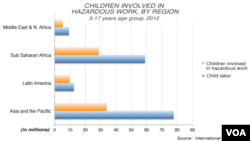ADDIS ABABA, ETHIOPIA —
The International Labor Organization, ILO, says the target of eliminating the worst forms of child labor will not be met by 2016, even though the global number of child laborers was reduced by one-third between 2000 and 2012. A newly released ILO report states that 168 million minors worldwide are still being forced to engage in child labor.
The study says the reduction of child labor is not going fast enough and that more action is needed.
Eleven percent of the world's children are being forced to engage in child labor, with more than half doing work that endangers their health, safety and moral development.
The director of the ILO office in Ethiopia, George Okutho, said a multi-faceted policy response is needed to further decrease the number of child laborers.
“We need to integrate child labor issues with issues of social protection, income generating capacity for households and also broader economic policy, legislation, education and labor market policies,” said Okutho.
While the largest number of child laborers are in Asia, with 77.7 million, Sub-Saharan Africa has the highest incidence, with more than one in five children engaged in the practice. The agricultural sector accounts for the highest number of child laborers, followed by the service sector.
The ILO report also points to positive trends noting a reduction in the total number of child laborers by one-third, from 246 million to 168 million, between 2000 and 2012.
George Okutho said the most significant progress was made between 2008 and 2012, despite the global economic crisis. He points to poverty reduction as an important factor.
“One way of preventing child labor is also to address the question of poverty. Child labor is very much related to poverty. Because children need to work to support their families in one way or another,” said Okutho.
Children between the ages of 5 and 17 doing work that adversely affects their physical and mental abilities are considered to be child laborers.
Several years ago, the 189 member states of the ILO set the year 2016 as the target for eliminating the worst forms of child labor.
That goal, according to the organization's latest report, will not be met.
Some information for this report provided by Ron Corben in Bangkok
The study says the reduction of child labor is not going fast enough and that more action is needed.
Eleven percent of the world's children are being forced to engage in child labor, with more than half doing work that endangers their health, safety and moral development.
The director of the ILO office in Ethiopia, George Okutho, said a multi-faceted policy response is needed to further decrease the number of child laborers.
“We need to integrate child labor issues with issues of social protection, income generating capacity for households and also broader economic policy, legislation, education and labor market policies,” said Okutho.
While the largest number of child laborers are in Asia, with 77.7 million, Sub-Saharan Africa has the highest incidence, with more than one in five children engaged in the practice. The agricultural sector accounts for the highest number of child laborers, followed by the service sector.
"In Asia also in many other parts much of child labor remains hidden," explained Simrin Singh, an ILO specialist on child labor in the Asia Pacific. "Certain forms of child labor are not well captured - such as child domestic work, children in child
domestic labor because they are hidden from public eyesight."
Singh said positive factors have supported the improvement, including better government policy and awareness, adding that Indonesia, the Philippines, as well as India and China have taken steps to implement significant social protection plans.
George Okutho said the most significant progress was made between 2008 and 2012, despite the global economic crisis. He points to poverty reduction as an important factor.
“One way of preventing child labor is also to address the question of poverty. Child labor is very much related to poverty. Because children need to work to support their families in one way or another,” said Okutho.
Children between the ages of 5 and 17 doing work that adversely affects their physical and mental abilities are considered to be child laborers.
Several years ago, the 189 member states of the ILO set the year 2016 as the target for eliminating the worst forms of child labor.
That goal, according to the organization's latest report, will not be met.
Some information for this report provided by Ron Corben in Bangkok





